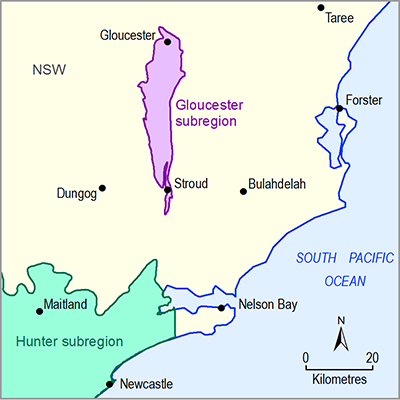- Home
- Assessments
- Bioregional Assessment Program
- Gloucester subregion
- 2.6.2 Groundwater numerical modelling for the Gloucester subregion
- 2.6.2.2 Review of existing models
- 2.6.2.2.2 Review of groundwater model for Duralie Coal Mine
HydroSimulations (2014), using Groundwater Vistas in conjunction with MODFLOW-SURFACT, developed a groundwater model for the Duralie Coal Mine. The model was developed to define the impact of open-cut coal mines on groundwater systems, which also included a few water supply bores that are currently in use, and groundwater levels in the alluvial aquifer. No quantitative cumulative impact assessment was undertaken due to the large distance from the nearest coal mining and AGL CSG activity areas.
The model extent is 5.85 km × 13 km with an approximate depth of 500 m comprising 260 rows by 117 columns, and about 212,940 active cells. The hydrostratigraphy of the model has four types of units divided into seven layers. The eastern and western boundaries were chosen to coincide with topographic ridge lines and outcrops of the Alum Mountain Volcanics.
The Mammy Johnsons River and Wards River are established as river cells in model Layer 1 using the RIV package, thereby allowing water exchange in either direction between the stream and the aquifer. Minor drainage lines were established as drain cells in the model using the DRN package, allowing groundwater to discharge to the drainage lines as baseflow.
The median river conductance per grid cell is 150 m2/day with a range from 10 to 450 m2/day. River stage elevations on Mammy Johnsons River are based on observed stage data from government (NSW Office of Water) gauging stations. The drain conductances per grid cell were set at 50 m2/day.
The model edges are considered as ‘no-flow’, with general head boundaries where Mammy Johnsons River enters and leaves the active model area in Layer 1. A wider general head boundary is applied across the alluvial extent of Wards River at the northern boundary. Equivalent general heads are applied through the stratigraphic section at the northern boundary. Drain cells are used to represent mining with a drain conductance per grid cell value of 0.2 m2/day.
Rainfall recharge has been imposed as a percentage of actual rainfall (for transient calibration) or long-term mean rainfall (for steady-state calibration and prediction simulations) across five zones: regolith (2.6%), hills (10.8%), alluvium (0.9%), subcropping coal seams (0.36%) and spoil zones (0.36 to 2.7%).
Evapotranspiration is applied uniformly using MODFLOW’s linear function, with a maximum rate of 3.7 mm/day and an extinction depth of 1.5 m. The recharge rates were determined during model calibration. Additional recharge zones were defined during predictive simulations for both the active mining area (zero recharge) and spoil infiltration (initially zero, then 5% after five years).
Local hydraulic conductivities are reported to range from 1 to 5 m/day for the alluvium and from 0.04 to 3 m/day for the coal seams in the 0 to 200 m depth interval.
Four separate model variants were presented: (i) steady-state calibration, (ii) transient calibration, (iii) transient prediction and (iv) post-mining recovery.
Steady-state calibration was performed against 167 head targets (observations) measured in various years, concentrated near current mining and the proposed Clareval North West open pit. Head targets were allocated to alluvium/regolith (10 points), coal measures/sandstones (15 points) and coal seams (142 points). Automatic calibration using PEST was done iteratively during steady-state and transient calibration on hydraulic conductivity, water storage properties, and recharge rates as a percentage of rainfall. Transient calibration proceeded from the heads estimated by the steady-state model, using 12 quarterly stress periods from January 2003 to December 2005. Sensitivity analysis was conducted for mine drain conductance, mine drain duration, river conductance and the vertical hydraulic conductivity of alluvium on predicted fluxes.
After calibration, the hydraulic conductivities for the coal seams vary between 0.01 and 0.15 m/day and between 1 x 10-6 and 0.5 m/day for the other stratigraphic layers, including the regolith. The ratio of horizontal to vertical conductivity ranges from 0.1 to 5 x 104. Specific yield varies between 0.005 and 0.08 and specific storage is 2 x 10-5 m-1 for the alluvium and regolith and 1 x 10-6 m-1 elsewhere. The drain conductance for drain cells representing mine dewatering was reduced to 0.2 m2/day.
The main hydrological changes predicted by this modelling are:
- There is no significant reduction in groundwater levels simulated in the alluvium.
- There is negligible impact on access to water in known registered production bores licensed to external parties.
- There is negligible loss of groundwater yield to surface stream systems (i.e. Mammy Johnsons River).
- Drawdowns are limited to the east, west and south by outcropping volcanics, propagate to the north, and are in the order of 1 to 2 m in the coal seams at the model boundary.
- There is substantial reduction in potentiometric head in the aquifers of the deeper groundwater system due east and to the north of the Duralie Coal Mine area.

Product Finalisation date
- 2.6.2.1 Methods
- 2.6.2.2 Review of existing models
- 2.6.2.3 Model development
- 2.6.2.4 Boundary and initial conditions
- 2.6.2.5 Implementation of coal resource development pathway
- 2.6.2.6 Parameterisation
- 2.6.2.7 Observations and predictions
- 2.6.2.8 Uncertainty analysis
- 2.6.2.9 Limitations and conclusions
- Citation
- Acknowledgements
- Currency of scientific results
- Contributors to the Technical Programme
- About this technical product
